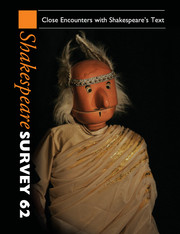Book contents
- Frontmatter
- Shakespeare, text and paratext
- The popularity of Shakespeare in print
- The continuing importance of new Bibliographical method
- ‘Honour the real thing’: Shakespeare, Trauma and Titus Andronicus in South Africa
- ‘O, these encounterers’: on Shakespeare’s meetings and partings
- A play of modals: Grammar and potential action in early Shakespeare
- Merry, marry, Mary: Shakespearian wordplay and Twelfth Night
- A subtle point: Sleeves, tents and ‘Ariachne’s broken woof’ (again)
- The look of Othello
- Red button Shakespeare
- ‘Mark you / his absolute shall?’: Multitudinous tongues and contested words in Coriolanus
- Chagall’s Tempest: An autobiographical reading
- Reading illustrated editions: Methodology and the limits of interpretation
- Close encounters with Anne Brontë's Shakespeare
- Shakespeare and the magic lantern
- Shakespeare and the coconuts: close encounters in post-apartheid South Africa
- The Schrödinger effect: Reading and misreading performance
- Behind the scenes
- Inner monologues: Realist acting and/as Shakespearian performance text
- More japanized, casual and transgender shakespeares
- Translation futures: Shakespearians and the foreign text
- After translation
- ‘The single and peculiar life’: Hamlet’s heart and the early modern subject
- Mapping King Lear
- ‘Last on the stage’: The place of Shakespeare in Charles Darwin’s ethology
- Sense/memory/sense-memory: Reading narratives of Shakespearian rehearsals
- Shakespeare performances in England (and Wales), 2008
- Professional Shakespeare productions in the British Isles, January–December 2007
- The Year's Contributions to Shakespearian Study 1 Critical Studies
- 2 Shakespeare in performance
- 3a Editions and textual studies
- 3b Editions and textual studies
- Index to Volume 62
2 - Shakespeare in performance
Published online by Cambridge University Press: 28 November 2009
- Frontmatter
- Shakespeare, text and paratext
- The popularity of Shakespeare in print
- The continuing importance of new Bibliographical method
- ‘Honour the real thing’: Shakespeare, Trauma and Titus Andronicus in South Africa
- ‘O, these encounterers’: on Shakespeare’s meetings and partings
- A play of modals: Grammar and potential action in early Shakespeare
- Merry, marry, Mary: Shakespearian wordplay and Twelfth Night
- A subtle point: Sleeves, tents and ‘Ariachne’s broken woof’ (again)
- The look of Othello
- Red button Shakespeare
- ‘Mark you / his absolute shall?’: Multitudinous tongues and contested words in Coriolanus
- Chagall’s Tempest: An autobiographical reading
- Reading illustrated editions: Methodology and the limits of interpretation
- Close encounters with Anne Brontë's Shakespeare
- Shakespeare and the magic lantern
- Shakespeare and the coconuts: close encounters in post-apartheid South Africa
- The Schrödinger effect: Reading and misreading performance
- Behind the scenes
- Inner monologues: Realist acting and/as Shakespearian performance text
- More japanized, casual and transgender shakespeares
- Translation futures: Shakespearians and the foreign text
- After translation
- ‘The single and peculiar life’: Hamlet’s heart and the early modern subject
- Mapping King Lear
- ‘Last on the stage’: The place of Shakespeare in Charles Darwin’s ethology
- Sense/memory/sense-memory: Reading narratives of Shakespearian rehearsals
- Shakespeare performances in England (and Wales), 2008
- Professional Shakespeare productions in the British Isles, January–December 2007
- The Year's Contributions to Shakespearian Study 1 Critical Studies
- 2 Shakespeare in performance
- 3a Editions and textual studies
- 3b Editions and textual studies
- Index to Volume 62
Summary
Two books, particularly significant in that they will stimulate and enable new work, locate performance authority in two different agents. John Russell Brown’s The Routledge Companion to Directors’ Shakespeare gathers thirty-one contributors each writing on a single director judged to be innovative in his (usually – on this more later) own time, to have a canon of work spanning some years to show development or change, and to have influenced other directors. Some of the figures highlighted are expected: it is good to have Maria Shevtsova’s account of Peter Brook’s working methods, and to read Matthew Wilson Smith’s reconstruction of the political and technical genesis of Orson Welles’s Harlem Macbeth. I for one was less familiar with some of the European directors selected: the work of Roger Planchon, including a prominent Henry IV in Lyons, or the importance of Giorgio Strehler to Italian dramatizations of Shakespeare with his commedia dell’arte Trinculo and Stephano (a relief from their so often being Scottish) and Brechtian Coriolanus. Some contributors have the knack of bringing productions into visual life – Carol Rutter on Deborah Warner’s Titus Andronicus, for example – although the understandable pragmatic decision not to include photographs does mean that a number of the productions cited remain very two-dimensional. The choice of subjects fills in some mid-century gaps with Guthrie, Byam Shaw, Iden Payne and Granville Barker all getting proper attention to their impact. Some directors are more familiar to English-speaking readers in relation to specific performances, and here the narrative accounts helpfully situate, say, Peter Zadek’s challenging Othello as a ‘Shakespearenegro, not a real one’ in the context of a longer career of engagement with Shakespeare’s plays in Hamburg, Berlin and Vienna. Directors known largely for Shakespeare films – Zeffirelli, Welles, Taymor – have their familiar and accessible cinema work revealingly reinstated alongside past theatrical explorations.
- Type
- Chapter
- Information
- Shakespeare Survey , pp. 414 - 420Publisher: Cambridge University PressPrint publication year: 2009

